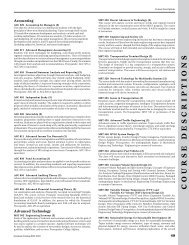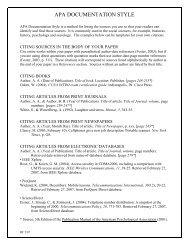Expanding the Public Sphere through Computer ... - ResearchGate
Expanding the Public Sphere through Computer ... - ResearchGate
Expanding the Public Sphere through Computer ... - ResearchGate
You also want an ePaper? Increase the reach of your titles
YUMPU automatically turns print PDFs into web optimized ePapers that Google loves.
CHAPTER 4. ABORTION DISCOURSE IN THE PUBLIC SPHERE 63<br />
cial movement organizations, and public opinion. In <strong>the</strong> years following Roe, a<br />
highly polarized era occurs, as large-scale “pro-choice” and “pro-life” movements<br />
emerge. This era is most succinctly marked by a succession of U.S. Supreme<br />
Court cases and repeated (unsuccessful) attempts to pass an amendment to <strong>the</strong><br />
Constitution prohibiting abortion. These efforts transformed <strong>the</strong> abortion issue<br />
into one that has remained broad-based and fully engaged for nearly a quartercentury.<br />
Although <strong>the</strong> Supreme Court has steadily whittled away at <strong>the</strong> ability of<br />
women to exercise <strong>the</strong>ir right to an abortion established by Roe, no more than four<br />
justices in any single case have indicated a willingness to expressly overturn <strong>the</strong><br />
decision. Those seeking such an outcome had anticipated success following <strong>the</strong><br />
string of steadily restrictive Court opinions and <strong>the</strong> ascension to <strong>the</strong> Court of five<br />
Reagan and Bush appointees (Tribe 1990). They were bitterly disappointed when,<br />
in <strong>the</strong> Casey decision in 1992, O’Connor, Kennedy and Souter reaffirmed, ra<strong>the</strong>r<br />
than rejected, <strong>the</strong> central holding in Roe. This left <strong>the</strong> bloc of Rehnquist, Scalia,<br />
Thomas and White one vote shy of reversal.<br />
The election of a pro-choice President in 1992, and <strong>the</strong> subsequent replacement<br />
of Justice White – who had dissented from <strong>the</strong> majority opinion in Roe and was<br />
willing to overturn that decision in Casey – it would appear that we may be on<br />
<strong>the</strong> cusp of a fourth phase in <strong>the</strong> abortion controversy in <strong>the</strong> United States. In<br />
this new phase, <strong>the</strong> right to an abortion, while still contested, is less <strong>the</strong> focus<br />
than <strong>the</strong> ability to obtain an abortion. Thus, <strong>the</strong> persuasive efforts of <strong>the</strong> pro-life<br />
movement are targeted to abortion service providers and consumers ra<strong>the</strong>r than<br />
policy makers. Given <strong>the</strong> unlikelihood of success in <strong>the</strong> Supreme Court, some<br />
pro-life advocates have essentially given up trying to change general attitudes<br />
<strong>through</strong> reasoned discourse, and are instead using or advocating (or at least not<br />
criticizing) <strong>the</strong> use of terror as a weapon against those providing abortion services<br />
(Donovan 1985, Forrest & Henshaw 1987, Terry 1988, Wills 1989, Grant 1991).<br />
4.2 Abortion Discourse in <strong>the</strong> <strong>Public</strong> <strong>Sphere</strong><br />
<strong>Public</strong> discussion about abortion moves <strong>through</strong> similar phases as public policy.<br />
There is some dispute about <strong>the</strong> public perception of abortion during <strong>the</strong> precriminalization<br />
phase. According to Luker (1984), <strong>the</strong>re is ample evidence that abortion<br />
was considered by some to be morally wrong. Popular home medical guides made<br />
clear that pregnancy was a biologically continuous process, with some opposing
















